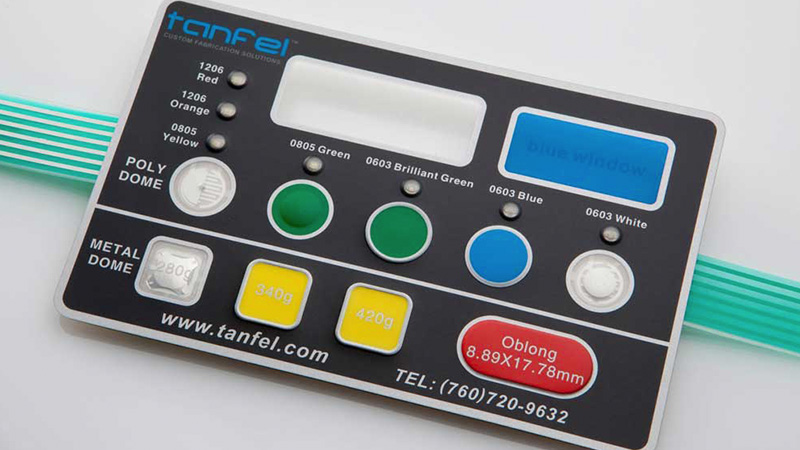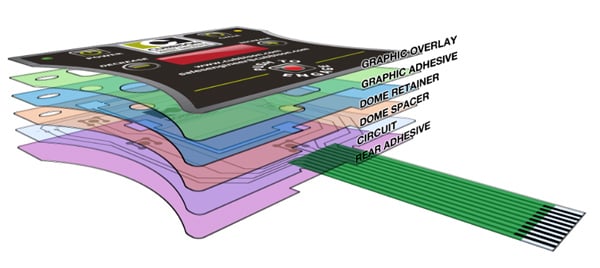How Membrane Switch Innovation Is Revolutionizing Modern User Interfaces
How Membrane Switch Innovation Is Revolutionizing Modern User Interfaces
Blog Article
Membrane Layer Switch Innovation: The Trick to Reputable and Economical User Interfaces
Membrane button technology has become a pivotal component in the layout of interface, supplying both reliability and cost-effectiveness throughout a varied variety of applications. Its robust building and construction ensures resistance to environmental obstacles, while the adaptability in style allows for customized remedies that meet certain industry needs. As we explore the multifaceted advantages of membrane buttons, their possibility for development increases questions concerning future applications and developing fads. What does the next chapter hold for this technology in a significantly digital landscape?
Recognizing Membrane Layer Switch Over Innovation
Membrane switch modern technology is a commonly utilized interface solution in different electronic devices, using a seamless mix of functionality and design. This innovation incorporates several layers of products, usually being composed of a visuals overlay, spacer layer, and a circuit layer. The graphic overlay presents the interface elements, while the spacer layer separates the circuit layer from the overlay until a customer turns on a switch.
When pressure is used to the overlay, the circuit layer completes the electric circuit, sending a signal to the device. This system enables for numerous setups, including responsive comments and backlighting alternatives, boosting user interaction. Membrane switches are usually manufactured utilizing resilient materials such as polyester or polycarbonate, ensuring longevity and resistance to environmental elements like dampness and dust.
The convenience of membrane layer switches over enables their application in diverse industries, consisting of clinical tools, consumer electronics, and industrial controls. Their compact design allows for assimilation right into space-constrained environments, supplying a reliable user interface without compromising aesthetic charm. Recognizing the complexities of membrane button technology is important for suppliers and developers seeking to develop reliable and reliable human-machine user interfaces.
Secret Advantages of Membrane Buttons
While different interface options exist, membrane layer switches over deal unique benefits that make them a favored option in countless applications. One of the key advantages is their toughness; membrane buttons are designed to hold up against harsh environmental problems, consisting of moisture, dirt, and temperature level changes, guaranteeing long-lasting performance. This durability significantly reduces the need for regular substitutes, thereby reducing general upkeep prices.

In addition, membrane buttons are lightweight and compact, making them appropriate for applications where space is limited. Their inconspicuous style adds to a smooth look without compromising capability.
Cost-effectiveness is additionally a remarkable benefit, as the production process for membrane switches over has a tendency to be much less pricey compared to typical mechanical switches. This price, integrated with their integrity and convenience of setup, positions membrane switches over as a functional remedy for a broad array of industries seeking effective and reliable interface.
Applications Throughout Numerous Industries
Just how do membrane buttons adjust to the varied needs of numerous industries? Membrane layer button innovation is significantly acknowledged for its flexibility, making it suitable for a wide variety of applications across numerous sectors.
In consumer electronics, membrane layer switches offer a portable remedy for remotes and home devices, improving customer experience through instinctive layout. Additionally, the industrial industry leverages membrane buttons for equipment control panels, taking advantage of their resistance to extreme settings, such as dampness and dust.
Armed forces and aerospace applications also use membrane layer switches for their integrity and capacity to endure extreme conditions, ensuring functional effectiveness in critical situations. The food and beverage industry embraces these switches for automated systems, where hygiene and convenience of procedure are paramount (membrane switch). Ultimately, membrane layer buttons are tailored to meet the special demands of each sector, confirming their essential duty in modern technology user interfaces
Layout and Personalization Options

In the world of membrane switch modern technology, design and customization choices play a crucial duty in boosting functionality and user interaction. These switches can be tailored to meet specific functional needs and visual choices, making them flexible components in different applications.
Among the primary customization alternatives is the format of the button itself, which can be created to accommodate read this article unique customer interfaces and ergonomic considerations. By changing the shape, size, and arrangement of link switches, makers can create user-friendly styles that help with convenience of use. Additionally, the incorporation of different colors and graphic overlays allows for branding and boosted presence, ensuring that individuals can promptly determine features.
In addition, membrane layer switches can be crafted with various tactile feedback mechanisms, such as increased switches or distinct clicks, to improve the individual experience. Different materials can likewise be picked for sturdiness and ecological resistance, addressing aspects such as dampness, temperature changes, and chemical exposure.
Ultimately, the considerable layout and customization options available in membrane switch technology encourage services to create tailored options that not just satisfy functional requirements but likewise straighten with their branding and functional needs.

Future Fads in Membrane Layer Switches
As membrane switch modern technology remains to evolve, future fads are increasingly focused on enhancing user experience and integrating innovative performances. One significant trend is the integration of touch-sensitive and capacitive technologies into traditional membrane layer buttons. This development enables more instinctive interface, providing tactile responses while preserving a sleek layout.
One more emerging trend is using eco-friendly materials, driven by the growing demand for sustainable production methods. Makers are looking for to minimize their carbon impact by making use of recyclable substrates and low-impact inks, straightening with international sustainability objectives.
In addition, the increase of the Net of Points (IoT) is triggering the unification of wise my sources features into membrane buttons. Improved connection options will enable gadgets to communicate with each various other, allowing for smooth combination right into broader systems.
Furthermore, advancements in printing technologies, such as digital printing, are permitting greater design versatility and modification. This allows producers to create intricate layouts and vivid shades cost-effectively.

Verdict
To conclude, membrane button innovation stands for a crucial development in interface style, supplying significant advantages in durability, customization, and cost-effectiveness. Its widespread applicability throughout varied markets emphasizes its importance in modern-day innovation. As improvements remain to emerge, especially in touch-sensitive user interfaces and lasting materials, the possibility for membrane layer switches to enhance user experience and performance remains promising. Continued expedition of this technology will likely produce additionally enhancements and widen its range in future applications.
Report this page